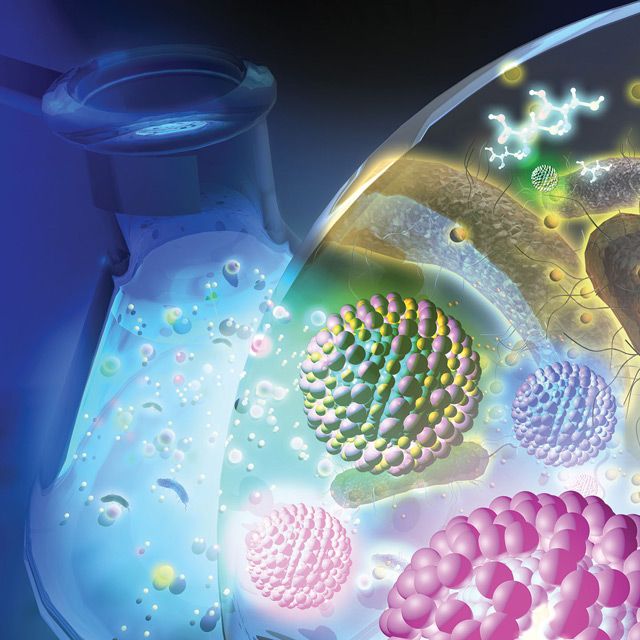Quantum dots (QDs)—man-made semiconducting nanoparticles with unmatched optical and electronic properties—are used in medical imaging, LEDs, lasers, solar cells and optoelectronics.
But QDs are expensive and complicated to make, and current chemical synthesis methods require heat, high pressure and toxic solvents.
Three Lehigh researchers recently demonstrated the first precisely controlled, biological way of making QDs. Their green, one-step method harnesses bacterial cells to generate QDs without heat or chemicals.
In a cover article published last July by Green Chemistry, Bryan Berger, Steven McIntosh and Christopher Kiely and their students reported the successful production of cadmium sulfide (CdS) QDs using an engineered form of the bacterium Stenotrophomonas maltophilia. Berger and McIntosh are associate professors of chemical and biomolecular engineering. Kiely is a professor of materials science and engineering.
Using a process called directed evolution, the group altered S. maltophilia so it selectively produced QDs. By confining the bacteria in a beaker containing water, cadmium and sulfur precursors, and minimal levels of carbon and nitrogen, the group caused the bacteria cells to forgo most normal biological functions.
The cells built QDs by sequestering metal ions from their environment, generating a reactive sulfur source, and controlling the resultant structure to form a crystal. The researchers then used a centrifuge to pull the much larger cells away from the CdS nanocrystals in solution.
The three-year-old project is supported by a $2 million grant from NSF’s Division of Emerging Frontiers in Research and Innovation (EFRI). The group also received funding from Lehigh’s Faculty Innovation Grant (FIG) and Collaborative Research Opportunity Grant (CORE) programs.
“The beauty of a biological approach is that it cuts down on production needs and time and on environmental burden,” says Berger. Industrial processes require hours to grow QDs as well as additional processing and purifying. Biosynthesis can take just minutes to make QDs in water by an inherently “green” route that operates at ambient conditions and does not require post-processing.
The group’s technique also enables QD particle size to be controlled to fractions of a nanometer, allowing the researchers to tune the QDs’ optical and electronic properties.
The group used an aberration-corrected scanning transmission electron microscope (AC-STEM) to examine the structure and composition of each QD, which is composed of only tens to hundreds of atoms.
“Even with this new microscope, we’re pushing the limits of what can be done,” says Kiely. The AC-STEM scans an ultra-fine electron beam across a field of QDs. The QD atoms scatter the electrons in the beam, producing a shadow image on a fluorescent screen. A digital camera records the highly magnified atomic resolution image of the nanocrystal for analysis.
Figuring out how to separate the QDs from all the biological material surrounding them was a slow but crucial process, says Kiely.
“Once you get rid of the organic residues, you begin to see the true structure of the material. It took many months of frustration for our students (Zhou Yang, Leah Spangler, Chris Curran, Robert Dunleavy and Li Lu) to determine exactly how to do this.”
A single enzyme in the bacteria is responsible for QD generation, says Berger. The group believes QDs can be generated at low cost with the same enzyme synthesized from yeast or another easily manipulated bacterium.
The team is scaling up its process in hopes of establishing a company that makes inexpensive QDs in an eco-friendly manner. Conventional manufacturing costs for CdS QDs range from $1,000 to $10,000 per gram. Biomanufacturing could cut that price by a factor of 10, producing grams of QDs per liter of batch culture, says McIntosh.
Their production technique, the researchers say, could lead to QD applications ranging from greener manufacturing of methanol to efficient generation of electricity from sunlight. Water purification and metal recycling are two other possible uses, because the enzyme makes QDs by isolating heavy metals from water.
“We also want to create many different types of functional materials, large-scale as well as individual quantum dots,” says McIntosh. He imagines developing a process by which QDs arrange themselves into macrostructures.
“If we can get to macroscale, make more of the material and control how it’s structured while maintaining its core functionality, we could potentially get a solar cell to assemble itself with quantum dots. That would be incredible.”

